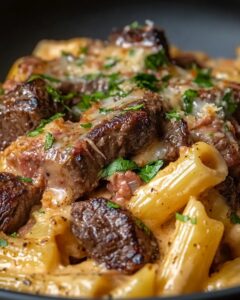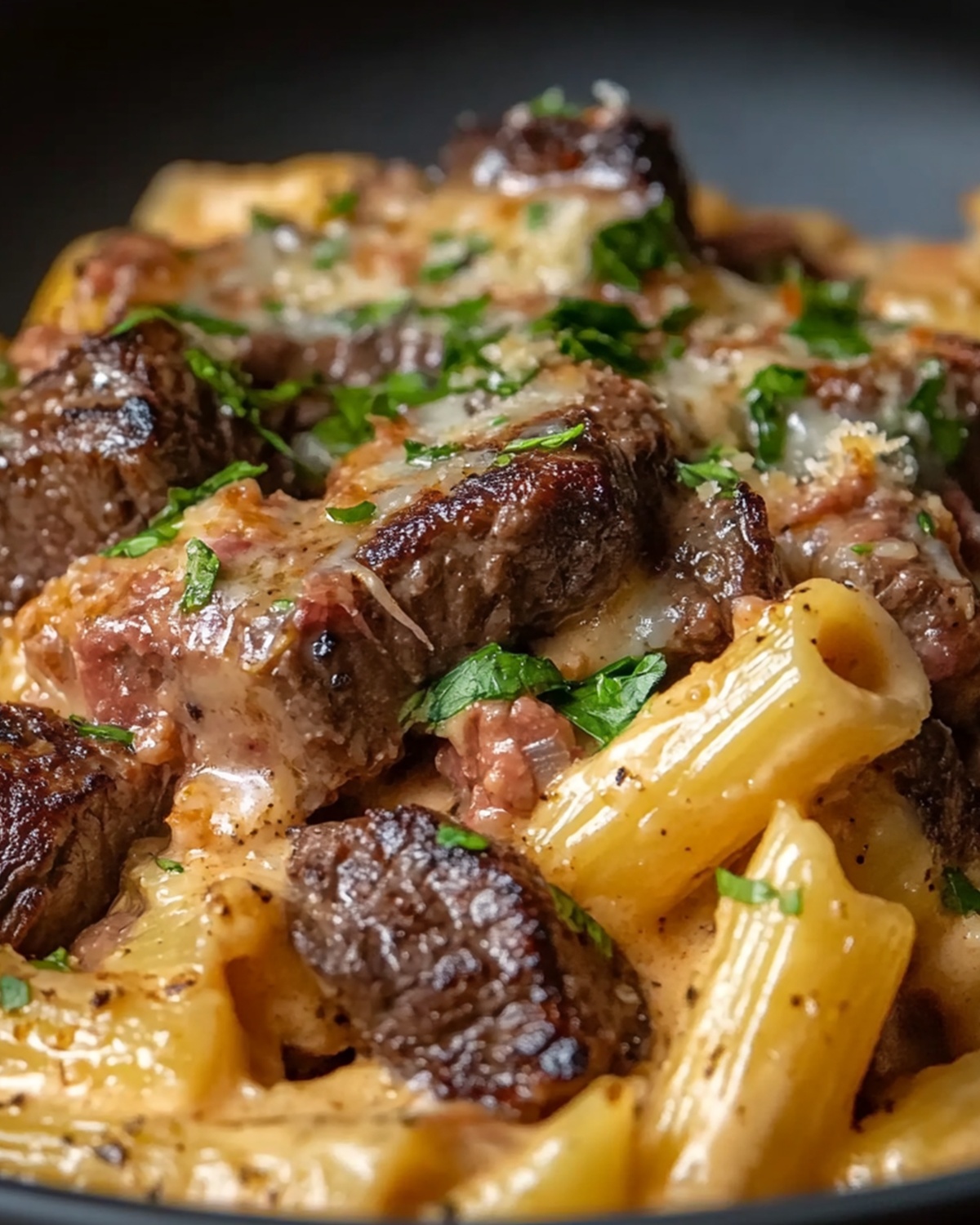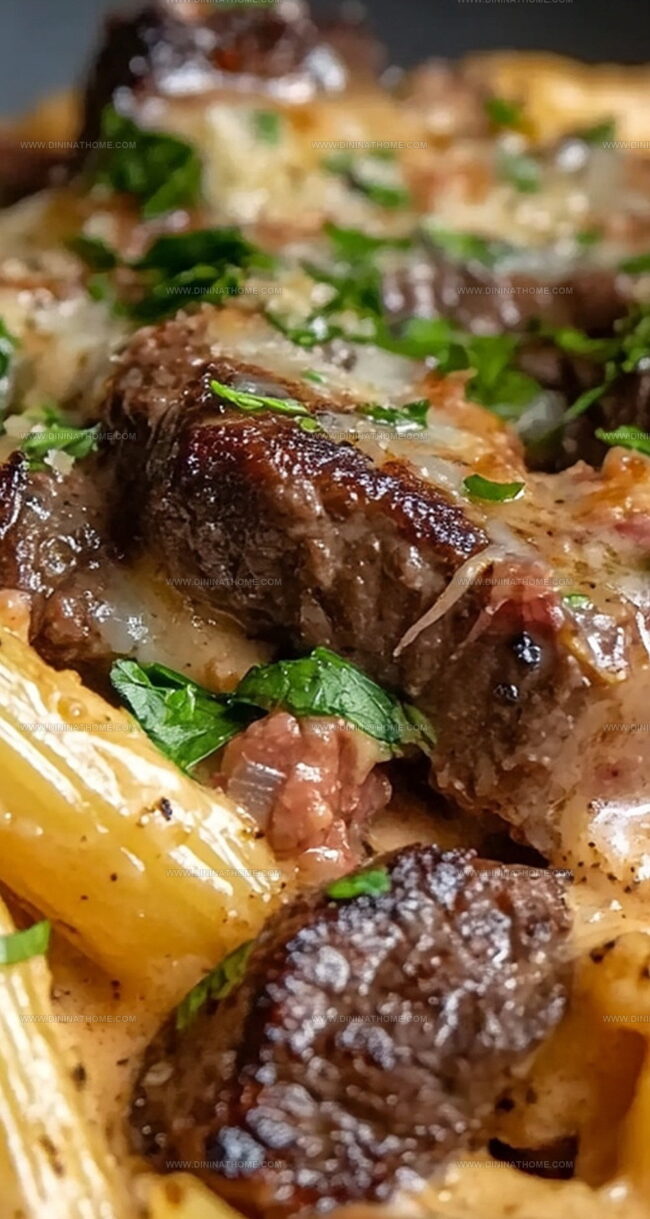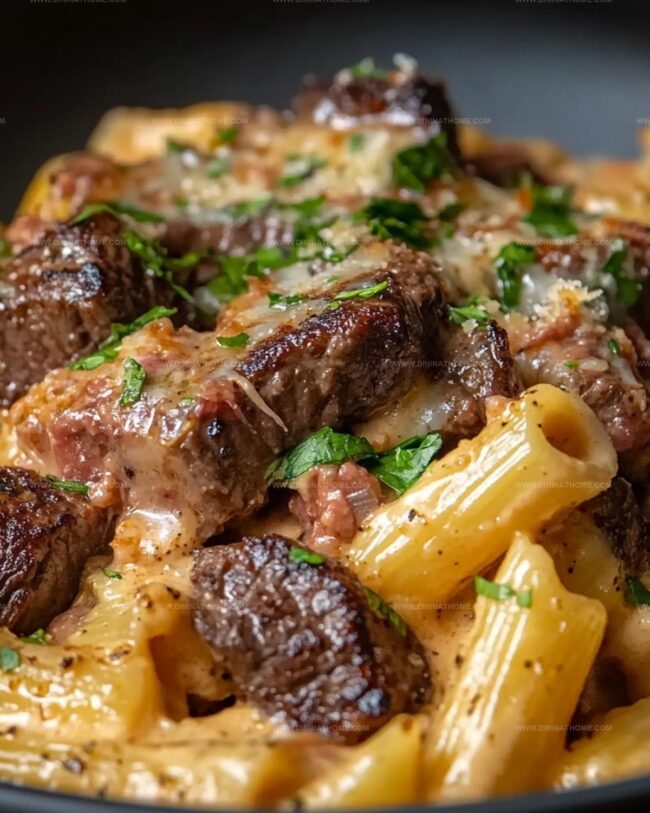Sizzling Cajun Steak Pasta Recipe: Zesty Comfort in Every Bite
Spicy aromas from a cajun steak pasta recipe waft through my kitchen, promising an adventurous meal.
Peppers and robust seasonings dance across tender meat and silky noodles.
Robust flavors blend southwestern heat with classic comfort food textures.
Creamy sauce coats each strand, creating memorable bites that spark conversation.
Regional spices kick traditional pasta into an exciting culinary experience.
Skilled home cooks can easily master this restaurant-quality dish with simple ingredients.
Prepare to savor every delicious forkful of this mouthwatering dinner.
Cajun Pasta With Steak That’s Creamy, Bold, And Filling
Cajun Steak Pasta Ingredient Checklist
Main Protein and Pasta:Seasoning and Spices:Sauce and Flavor Enhancers:Finishing Touches:Cajun Steak Pasta Cooking Made Easy
Step 1: Spice Up the Steak
Generously coat both sides of the steak with a blend of:Heat a skillet to high temperature and sear the steak for about 1.5 minutes on each side for a perfect medium-rare doneness.
Transfer the steak to a cutting board and let it rest while preparing the other components.
Step 2: Boil the Pasta
Fill a large pot with water and add a pinch of salt.
Bring to a rolling boil and cook the pasta until it reaches that perfect al dente texture.
Drain and set aside.
Step 3: Craft the Creamy Sauce
In the same skillet used for the steak, create a flavorful base by sautéing:Soften the vegetables until they become fragrant and translucent.
Introduce cream cheese and additional seasonings:Pour in some pasta water and crumble a beef stock cube into the mixture.
Stir until everything combines into a rich, creamy sauce.
Step 4: Slice the Steak
Carefully cut the rested steak into bite-sized cubes, ensuring each piece is roughly the same size for even distribution.
Step 5: Bring It All Together
Gently toss the cooked pasta in the creamy sauce.
Sprinkle generously with grated parmesan cheese.
Arrange the steak cubes on top of the pasta.
Drizzle any remaining sauce over the dish.
Finish with a sprinkle of fresh chopped parsley for a burst of color and freshness.
Flavorful Finishing Tips for Cajun Steak Pasta
Store Cajun Steak Pasta Leftovers
Pasta or Salads to Pair with Cajun Steak Pasta
Cajun Steak Pasta New Styles
FAQs
A blend of spices like paprika, garlic powder, black pepper, oregano, and cayenne that originates from Louisiana, giving dishes a spicy and robust flavor profile.
Yes, ribeye, sirloin, or New York strip work well. Choose a cut that’s tender and has good marbling for the best results.
The heat level depends on the amount of Cajun seasoning used. You can adjust the spiciness by adding more or less seasoning to suit your taste preferences.
Almost! While you’ll use multiple steps, everything is primarily prepared in the same skillet, making cleanup easier and preserving the delicious flavor buildup from cooking.
Print
Cajun Steak Pasta Recipe
- Total Time: 25 minutes
- Yield: 2 1x
Description
Spicy Cajun steak pasta delivers a bold culinary journey through Louisiana’s hearty flavors. Creamy sauce and perfectly seasoned steak create a mouthwatering experience you won’t forget.
Ingredients
Main Ingredients:
- 200 grams (7.05 ounces) sirloin steak
- 120 grams (4.23 ounces) dry pasta
- 70 grams (2.47 ounces) reduced-fat garlic herb cream cheese
Seasonings and Spices:
- 1 teaspoon Cajun seasoning
- 1 teaspoon smoked paprika
- Salt and pepper to taste
- 1 crumbled beef stock cube
Vegetables and Herbs:
- 1 small white onion, diced
- 1 small red pepper, diced
- 1 teaspoon garlic puree
- 3 sprigs parsley, chopped
- 10 grams (0.35 ounces) grated parmesan cheese
Liquid:
- 150 milliliters (5.07 fluid ounces) pasta water
Instructions
- Massage the steak generously with Cajun seasoning, smoked paprika, salt, and pepper, ensuring even coverage on both sides.
- Heat a skillet to high temperature and sear the steak for approximately 1.5 minutes per side, achieving a perfect medium-rare doneness. Transfer to a cutting board and allow to rest.
- Bring a large pot of salted water to a rolling boil and cook the pasta until it reaches al dente texture, maintaining a slight firmness.
- In the same skillet used for the steak, sauté minced garlic, diced onions, and sliced red peppers until they become translucent and fragrant.
- Introduce cream cheese to the vegetable mixture, blending in additional Cajun seasoning, smoked paprika, salt, and pepper to create a rich, creamy base.
- Deglaze the pan with reserved pasta water and crumble the beef stock cube, stirring thoroughly to create a smooth, flavorful sauce.
- Slice the rested steak into bite-sized cubes, ensuring even pieces for consistent distribution.
- Combine the cooked pasta with the prepared sauce, tossing gently to coat each strand evenly.
- Sprinkle freshly grated parmesan over the pasta and arrange the steak cubes on top.
- Finish the dish by drizzling any remaining sauce and garnishing with chopped fresh parsley for a burst of color and flavor.
Notes
- Choose a high-quality cut like ribeye or sirloin for maximum flavor and tenderness when preparing Cajun steak pasta.
- Adjust Cajun seasoning intensity based on personal spice tolerance, using less for mild palates or more for heat lovers.
- Rest the steak for 5-7 minutes after cooking to lock in juices and ensure optimal meat texture when slicing.
- Use heavy cream instead of cream cheese for a lighter, smoother sauce that coats pasta more evenly.
- Prep Time: 10 minutes
- Cook Time: 15 minutes
- Category: Dinner, Lunch
- Method: Frying
- Cuisine: Cajun
Nutrition
- Serving Size: 2
- Calories: 620
- Sugar: 3g
- Sodium: 800mg
- Fat: 18g
- Saturated Fat: 7g
- Unsaturated Fat: 9g
- Trans Fat: 0g
- Carbohydrates: 75g
- Fiber: 3g
- Protein: 35g
- Cholesterol: 80mg





James Walker
Lead Recipe Developer & Culinary Educator
Expertise
Southern Cuisine & Farm-to-Table Cooking, Recipe Development & Testing, Culinary Education & Instruction
Education
School: Auguste Escoffier School of Culinary Arts
Program: Diploma in Culinary Arts and Operations
Focus: Comprehensive training in classical and modern culinary techniques, kitchen operations, and farm-to-table practices.
James didn’t learn cooking from a TV show, he learned it from busy kitchens, family gatherings, and long afternoons spent testing recipes the hard way.
After training at the Auguste Escoffier School of Culinary Arts, he brought his love for real, down-to-earth food to every dish he makes.
At Dining At Home, James loves building recipes that feel familiar but still have something special, like adding a twist to a classic or making a slow Sunday dinner feel brand new.
When he’s not in the kitchen, you’ll probably find him swapping garden tips at the farmers’ market or teaching his daughter how to flip pancakes without a mess (almost).